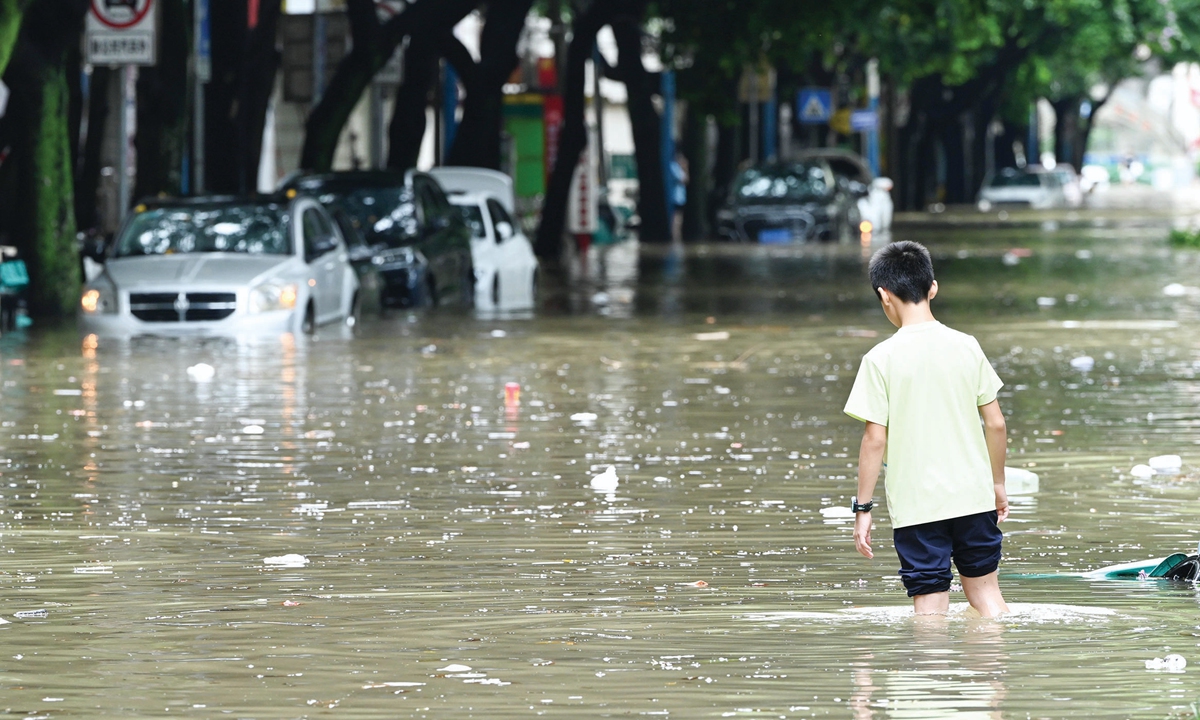Extremely heavy rainstorm hits South China’s Guangxi, leaving multiple cities waterlogged

A boy tries to navigate a flooded street in Nanning, South China's Guangxi Zhuang Autonomous Region, on May 19, 2024. Over the weekend, many areas in Guangxi were hit by heavy rainstorms, causing severe flooding. Photo: VCG
An extremely heavy rainstorm has swept through South China's Guangxi Zhuang Autonomous Region since Saturday, with several cities in the region being hit by rainstorms of records-breaking rainfall precipitations and multiple cities drenched in waterlogging.
According to the local meteorological authority in Guangxi, the rainstorm has affected the northern and the middle parts as well as the coastal parts of Guangxi. Multiple places including Qinzhou, Fangchengguang and Nanning were hit by extremely heavy rainstorms.
Longmengang township in Qinzhou recorded an accumulated rainfall precipitation of 610.5 millimeters in 24 hours, breaking the records for volume of precipitation. On early Sunday morning, the town's downpour precipitation in an hour hit a record high of 189.6 millimeters, breaking the historic record of hourly rainfall in Guangxi.
The local meteorological authority forecast that the heavy rainstorms in some places can pose high risks of disasters including mountain flooding, geological disasters as well as urban and rural waterlogging.
The Guangxi meteorological authority forecast the heavy rainfalls would continue until Sunday night and the rainfalls would weaken significantly during the daytime of Monday, with scattered showers or thunderstorms to be expected across the region.
Affected by the heavy rainstorms, three rivers in Guangxi suffered from flooding and the water level of these rivers would continue to rise by 0.3 meters to 0.5 meters, according to the local hydrological station in Guangxi, which initiated on Friday a IV-level emergency response to hydrologic forecasting.
Since Saturday, when the heavy rainstorm started affecting Guangxi, severe waterlogging has occurred in Fangchenggang with villages seeing rising water levels and water entering residential houses. As the rain band continued to move eastward along the coastal areas of Guangxi, the cities of Qinzhou and Beihai have continued to issue red alerts for rainstorms. The water levels in some flooded road sections in cities including Beihai, Qinzhou and Fangchenggang were as deep as 1 meter.
The local bureau of housing and urban-rural development in Nanning has launched a level-I emergency response for urban flooding prevention. A total of 661 people from the city's emergency response department are participating in the flood control response.
According to statistics from the emergency response management bureau of the autonomous region, from the early hours to 2 pm on Sunday, the heavy rainfall affected more than 35,260 people in Guangxi, with 554 people urgently relocated, among whom 231 were from Nanning and 295 from Qinzhou.
Video clips showing residents and vehicles were stranded in waterlogged streets in Guangxi. A local resident was forced to break the wall of his house which had become flooded.
The National Meteorological Center issued an orange alert for rainstorm at 10 am on Sunday, forecasting that between Sunday afternoon and Monday afternoon, heavy rainstorms are expected to sweep through multiple provinces and autonomous region including Guangdong, Fujian, Yunnan, Hainan and Guangxi.
The coastal areas in the southeastern part of Guangxi and the coastal areas in the southwestern part of Guangdong are expected to see extremely heavy rainfalls of 250 millimeters to 300 millimeters per hour.
According to Ma Jun, director of the Beijing-based Institute of Public and Environmental Affairs, this year's flood season in the southern part of China started more than one month earlier than usual.
The rain band drenched Nanning and Qinzhou between Saturday evening and Sunday morning is slowly moving eastward and is expected to affect the border area of Guangxi and Guangdong and even the Pearl River Delta region where precautionary measures against the impact of heavy rainstorms needed to be done in advance, Ma told the Global Times on Sunday.
The extremely heavy rainfall in such a short period of time has caused severe waterlogging in multiple cities and some rivers have been suffering flooding, Ma reminded that preparations against landslides and debris flows have to be made.
According to NMC's chief forecaster Zhang Tao, this round of precipitation is due to the strengthening and northward movement of the South China Sea monsoon, which encountered dry and cold air in the Jiangnan and South China regions, resulting in rainfall. This monsoon surge (a phase of intensified monsoon) is gradually shifting eastward day by day, causing strong rainfall in the South China region from west to east.



